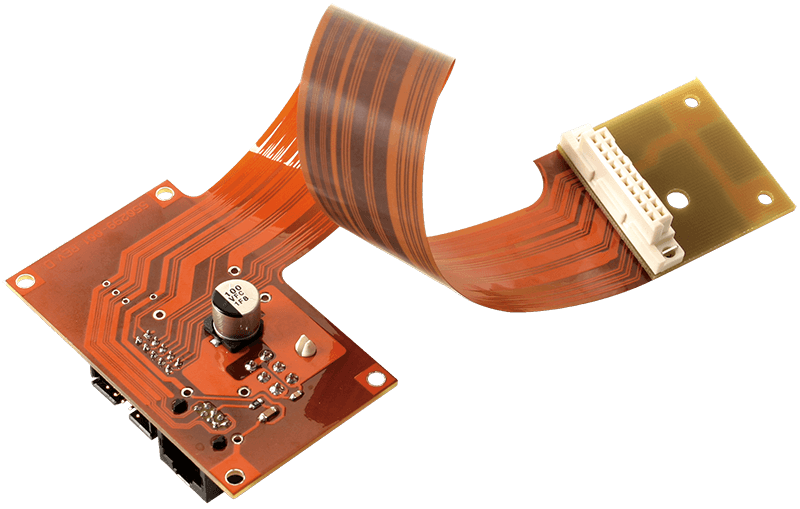Flexible PCB Solutions
Do more with a Flexible Circuit Board
What are Flexible Printed Circuits? A flexible printed circuit is a bendable electronic circuit that offers customizable and versatile design options. With a flexible circuit board from All Flex Solutions, you gain the power to revolutionize your electronic designs, unlocking limitless possibilities and advanced functionality.
- Imagine seamlessly integrating a thin metallic layer, typically copper, with a flexible dielectric layer, usually polyimide, to achieve your exact thickness specifications—from ultra-thin (< .0001″) to robust (> .010″).
- By using adhesive-less laminates and alternative bonding techniques, a flexible circuit board provides superior performance, better thermal management, and more integration possibilities compared to traditional methods.
- Because copper tends to easily oxidize, exposed surfaces are covered with a gold or solder protective layer increase conductivity and ensure environmental durability. Meanwhile, non-contact areas are fortified with dielectric materials to enhance reliability and longevity.
- Different from conventional printed circuit boards (PCBs), flexible PCBs are flexible, versatile, and can cater to diverse design needs and intricate applications. Despite its name, modern flexible printed circuits leverage advanced manufacturing techniques like photo imaging or laser imaging for precise pattern definition, ensuring accuracy and efficiency.
Advantages of Flexible Printed Circuits
Imagine having a flexible PCB that bends, folds, and conforms to nearly any shape or thickness you envision, offering unprecedented design flexibility for electronics. Unlike traditional rigid boards, size and space constraints become minimal concerns. Flexible printed circuits offer greater possibilities and design innovation, allowing you to create compact, lightweight, and exceptionally functional electronic packages.
This flexibility not only expands design possibilities but also reduces assembly and handling costs by integrating the entire interconnect system into a single part. With All Flex’s expertise in component assembly and testing, the entire process is kept in-house eliminating the need for multiple vendors while making the supply chain streamlined and efficient.
The Manufacturing Process At a Glance
Flexible Circuit Board Fabrication
There are two basic manufacturing processes for a flexible circuit board: Subtractive and additive:
Subtractive:
In a subtractive process, one starts with a solid area of metal, and the unwanted areas of metal are removed to form the traces. Screen printing and photo imaging are the two most common processes used for defining the circuitry pattern. The subtractive processes are more robust, cost effective, and allow for greater choices in final product configuration.
Additive:
In an additive process, one starts with a bare dielectric layer and the metallic traces are added only where needed to form the circuit. The conductive layer can be printed, plated, or deposited in a variety of manners. The flexible circuit boards created by the additive process have less current-carrying capability and environmental resistance than circuits created by the subtractive processes.
Subtractive:
In a subtractive process, one starts with a solid area of metal, and the unwanted areas of metal are removed to form the traces. Screen printing and photo imaging are the two most common processes used for defining the circuitry pattern. The subtractive processes are more robust, cost effective, and allow for greater choices in final product configuration.
Additive:
In an additive process, one starts with a bare dielectric layer and the metallic traces are added only where needed to form the circuit. The conductive layer can be printed, plated, or deposited in a variety of manners. The flexible circuit boards created by the additive process have less current-carrying capability and environmental resistance than circuits created by the subtractive processes.
Flexible Circuit Board Finishing and Assembly
Surface Finishing:
After fabrication, surface finishing is essential to prepare the flexible circuit board for bonding. Metals such as nickel gold, tin, silver and solder are ideas for processes like SMT assembly, wire bonding, or pressure connector insertion. Organic coatings can also protect the copper until bonding, after which the coating dissolves.
Assembly:
There are countless assembly options for flexible printed circuits. In addition to electronic components and connectors, a variety of electrical or mechanical devices can be attached to a flexible PCB. The circuit can also be easily bonded to a curved surface or formed to any 3 dimensional shape. With proper construction a flexible circuit board can handle dynamic flexing making it the ideal solution for electronic packages that connect moving or rotating parts.
After fabrication, surface finishing is essential to prepare the flexible circuit board for bonding. Metals such as nickel gold, tin, silver and solder are ideas for processes like SMT assembly, wire bonding, or pressure connector insertion. Organic coatings can also protect the copper until bonding, after which the coating dissolves.
Assembly:
There are countless assembly options for flexible printed circuits. In addition to electronic components and connectors, a variety of electrical or mechanical devices can be attached to a flexible PCB. The circuit can also be easily bonded to a curved surface or formed to any 3 dimensional shape. With proper construction a flexible circuit board can handle dynamic flexing making it the ideal solution for electronic packages that connect moving or rotating parts.
